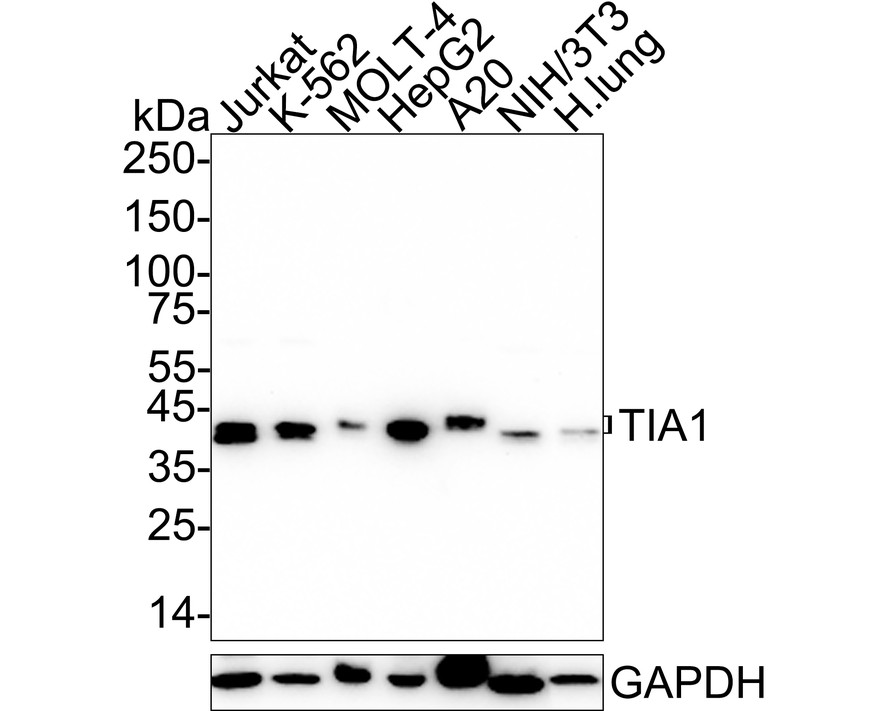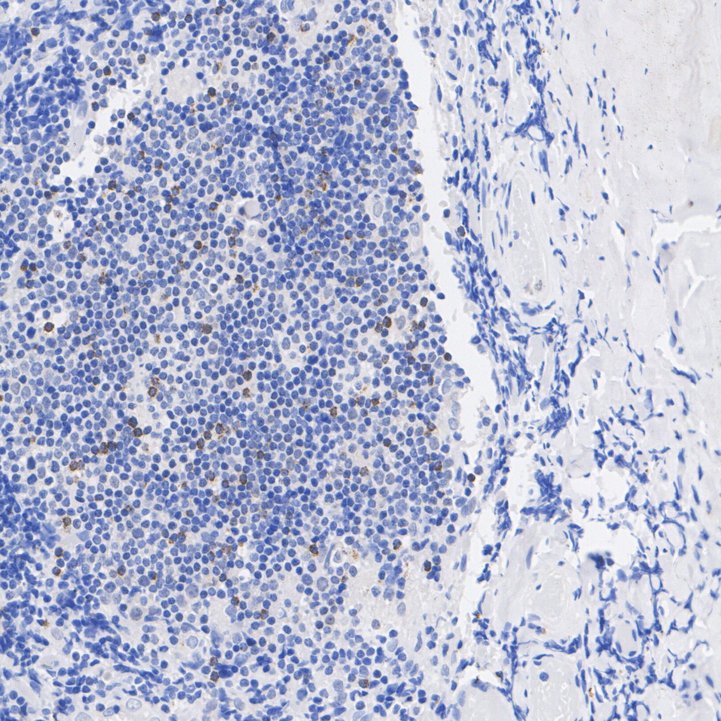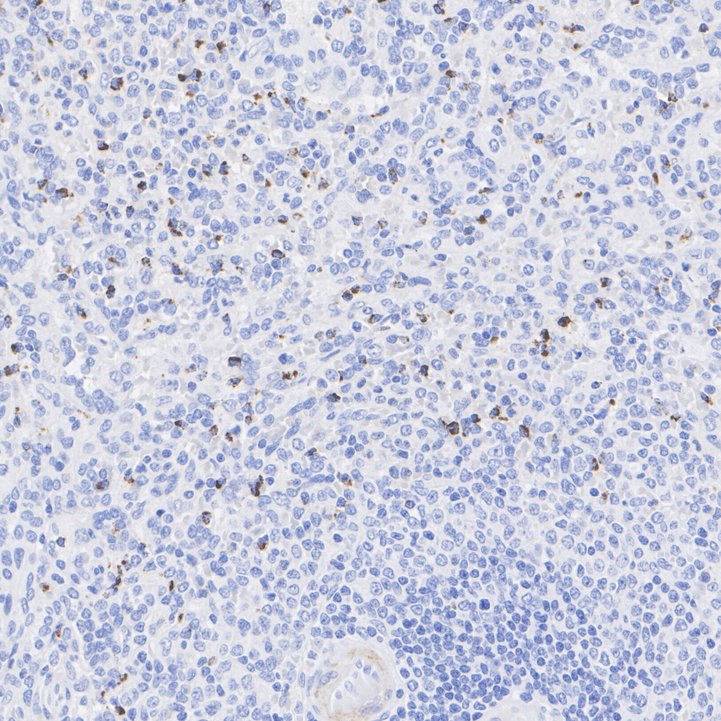TIA1 Recombinant Rabbit Monoclonal Antibody [JM42-11]

cat.: ET1703-59
| Product Type: | Recombinant Rabbit monoclonal IgG, primary antibodies |
|---|---|
| Species reactivity: | Human, Mouse |
| Applications: | WB, IF-Tissue, IHC-P, IP |
| Clonality: | Monoclonal |
| Clone number: | JM42-11 |
| Form: | Liquid |
| Storage condition: | Shipped at 4℃. Store at +4℃ short term (1-2 weeks). It is recommended to aliquot into single-use upon delivery. Store at -20℃ long term. |
| Storage buffer: | 1*TBS (pH7.4), 0.05% BSA, 40% Glycerol. Preservative: 0.05% Sodium Azide. |
| Concentration: | 1ug/ul |
| Purification: | Protein A affinity purified. |
| Molecular weight: | Predicted band size: 43 kDa |
| Isotype: | IgG |
| Immunogen: | Synthetic peptide within Human TIA1 aa 353-386 / 386. |
| Positive control: | Jurkat cell lysate, K-562 cell lysate, MOLT-4 cell lysate, HepG2 cell lysate, A20 cell lysate, NIH/3T3 cell lysate, Human lung tissue lysate, human tonsil tissue, human spleen tissue. |
| Subcellular location: | Nucleus, Cytoplasm, Stress granule. |
| Recommended Dilutions:
WB IF-Tissue IHC-P IP |
1:500-1:2,000 1:50 1:200-1:1,000 1-2μg/sample |
| Uniprot #: | SwissProt: P31483 Human | P52912 Mouse |
| Alternative names: | Cytotoxic granule associated RNA binding protein 1 Cytotoxic granule associated RNA binding protein mTIA-1 Nucleolysin TIA 1 isoform p40 Nucleolysin TIA-1 isoform p40 Nucleolysin TIA1 isoform p40 p40 TIA 1 p40-TIA-1 (containing p15-TIA-1) p40-TIA-1 RNA binding protein TIA 1 RNA binding protein TIA1 RNA-binding protein TIA-1 T-cell-restricted intracellular antigen-1 TIA 1 TIA 1 cytotoxic granule associated RNA binding protein Tia TIA-1 TIA1 TIA1 cytotoxic granule associated RNA binding protein TIA1 cytotoxic granule associated RNA binding protein like 1 TIA1 protein TIA1_HUMAN TIAL1 TIAR WDM |
Images

|
Fig1:
Western blot analysis of TIA1 on different lysates with Rabbit anti-TIA1 antibody (ET1703-59) at 1/2,000 dilution. Lane 1: Jurkat cell lysate (15 µg/Lane) Lane 2: K-562 cell lysate (15 µg/Lane) Lane 3: MOLT-4 cell lysate (15 µg/Lane) Lane 4: HepG2 cell lysate (15 µg/Lane) Lane 5: A20 cell lysate (15 µg/Lane) Lane 6: NIH/3T3 cell lysate (15 µg/Lane) Lane 7: Human lung tissue lysate (30 µg/Lane) Predicted band size: 43 kDa Observed band size: 41/43 kDa Exposure time: 2 minutes 6 seconds; ECL: K1801; 4-20% SDS-PAGE gel. Proteins were transferred to a PVDF membrane and blocked with 5% NFDM/TBST for 1 hour at room temperature. The primary antibody (ET1703-59) at 1/2,000 dilution was used in 5% NFDM/TBST at 4℃ overnight. Goat Anti-Rabbit IgG - HRP Secondary Antibody (HA1001) at 1/50,000 dilution was used for 1 hour at room temperature. |

|
Fig2:
Immunohistochemical analysis of paraffin-embedded human tonsil tissue with Rabbit anti-TIA1 antibody (ET1703-59) at 1/200 dilution. The section was pre-treated using heat mediated antigen retrieval with sodium citrate buffer (pH 6.0) for 2 minutes. The tissues were blocked in 1% BSA for 20 minutes at room temperature, washed with ddH2O and PBS, and then probed with the primary antibody (ET1703-59) at 1/200 dilution for 1 hour at room temperature. The detection was performed using an HRP conjugated compact polymer system. DAB was used as the chromogen. Tissues were counterstained with hematoxylin and mounted with DPX. |

|
Fig3:
Immunohistochemical analysis of paraffin-embedded human spleen tissue with Rabbit anti-TIA1 antibody (ET1703-59) at 1/1,000 dilution. The section was pre-treated using heat mediated antigen retrieval with sodium citrate buffer (pH 6.0) for 2 minutes. The tissues were blocked in 1% BSA for 20 minutes at room temperature, washed with ddH2O and PBS, and then probed with the primary antibody (ET1703-59) at 1/1,000 dilution for 1 hour at room temperature. The detection was performed using an HRP conjugated compact polymer system. DAB was used as the chromogen. Tissues were counterstained with hematoxylin and mounted with DPX. |

|
Fig4:
Immunofluorescence analysis of paraffin-embedded human spleen tissue labeling TIA1 with Rabbit anti-TIA1 antibody (ET1703-59) at 1/50 dilution. The section was pre-treated using heat mediated antigen retrieval with Tris-EDTA buffer (pH 9.0) for 20 minutes. The tissues were blocked in 10% negative goat serum for 1 hour at room temperature, washed with PBS, and then probed with the primary antibody (ET1703-59, green) at 1/50 dilution overnight at 4 ℃, washed with PBS. Goat Anti-Rabbit IgG H&L (iFluor™ 488, HA1121) was used as the secondary antibody at 1/1,000 dilution. Nuclei were counterstained with DAPI (blue). |
Note: All products are “FOR RESEARCH USE ONLY AND ARE NOT INTENDED FOR DIAGNOSTIC OR THERAPEUTIC USE”.